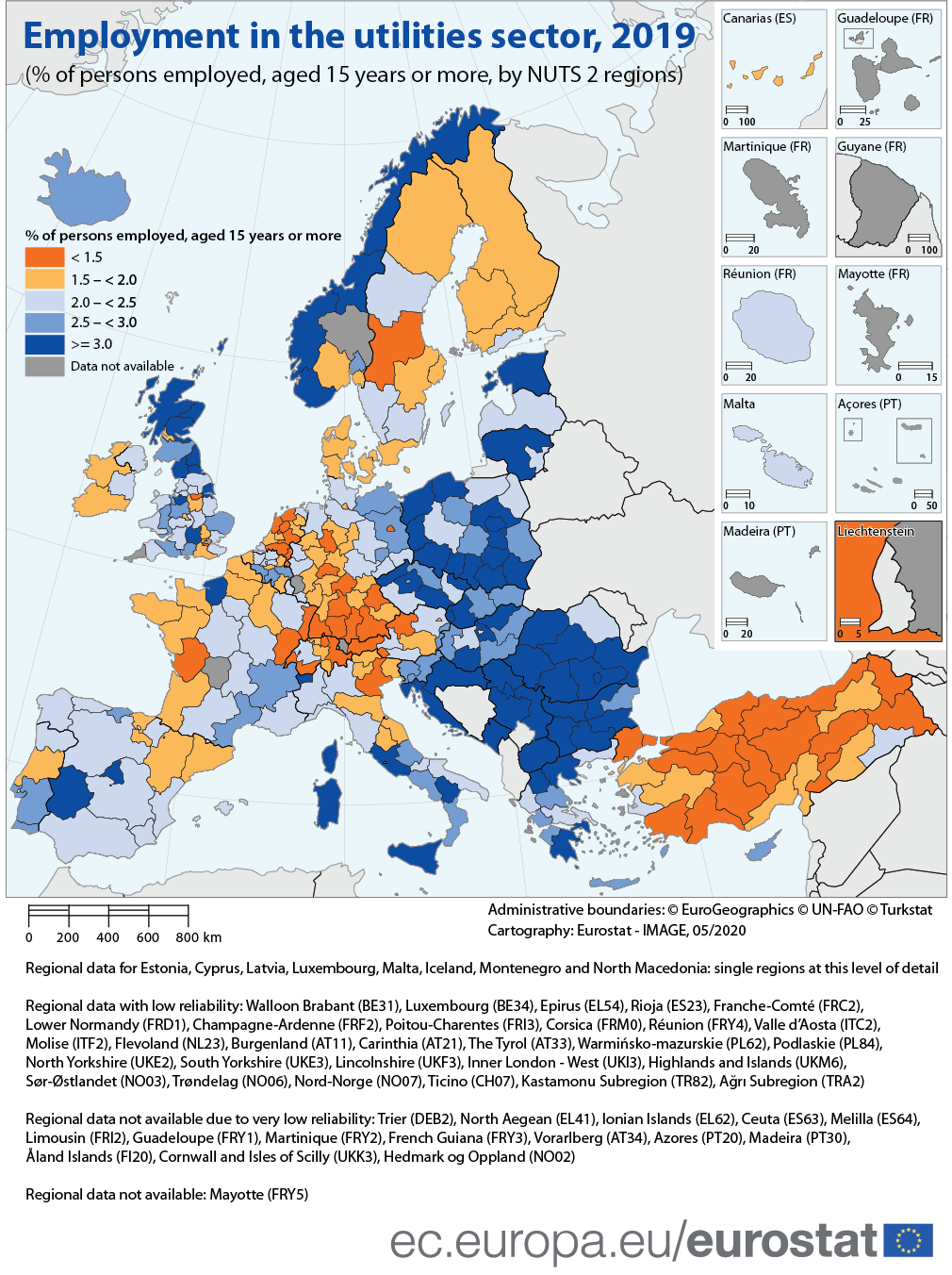In 2019, 4.6 million persons aged 15 years or older were employed in the utilities sector in the European Union (EU), representing 2.3% of all persons employed.
The utilities sector covers electricity, gas, steam and air conditioning supply (31% of the employment in the sector), waste collection, treatment and disposal activities (22%), telecommunications (19%), retail sale of automotive fuel in specialised store (10%), water collection, treatment and supply (9%), manufacture of coke and refined petroleum products (4%), sewerage (3%), as well as remediation activities and other waste management services (1%), extraction of crude petroleum and natural gas (1%) and support activities for petroleum and natural gas extraction (1%).
The utilities sector is critical for keeping society going, even in the middle of the coronavirus crisis. It continues to provide hospitals, homes, factories and other buildings with electricity, gas and water; it keeps our sewers running while we are confined in our homes; it makes home office and home school possible; it provides fuel for transport of medical supplies, food and other essential goods during this difficult period.
The utilities sector is male dominated. In 2019, almost three quarters (73%) of the workers in the sector were men. Most of the workers employed in this sector in the EU were aged 35-49 (40%), while one in three (33%) were aged 50 or above. Only one quarter (27%) of the workers in the sector were aged 15-34.
Croatia recorded the highest share of utility workers in 2019
Croatia stood out among the EU Member States in 2019, with 4.8% of the employed persons aged over 15 working in the utilities sector. This sector employed many people also in Bulgaria (3.8% of total employment) and Romania (3.7%), as well as in Greece (3.4%) and Poland (3.2%).
In contrast, only 1.4% of the persons employed in the Netherlands in 2019 worked in the utilities sector, with low shares also recorded in Denmark and Austria (both 1.7%) and in Germany, Finland and Sweden (all 1.8%).
Highest share of utility workers in the Greek region West Macedonia
Employment in the utilities sector accounted for 5.8% of total employment in the Greek region West Macedonia in 2019, the highest among the regions in the EU (NUTS 2 regions). The regions coming closest to this were the region South-West Oltenia in Romania with 5.6% of total employment, the region North-West in Bulgaria with 5.4% and Continental Croatia with 5.0%.
In contrast, only 1.0% of the persons employed worked in the utilities sector in the region of Upper Austria, closely followed by Giessen in Germany and North Brabant and Limburg in the Netherlands, where the share of workers in the utilities stood at 1.1% of total employment in 2019.
Notes:
- This comparison analyses regions at NUTS 2 level. More information on the NUTS classification of European regions can be found here.
- The utilities sector described in this article, as defined by the NACE Rev. 2 classification, includes the economic activities: 06 – Extraction of crude petroleum and natural gas; 09.1 – Support activities for petroleum and natural gas extraction; 19 – Manufacture of coke and refined petroleum products; 35 – Electricity, gas, steam and air conditioning supply; 36 – Water collection, treatment and supply; 37 – Sewerage; 38 – Waste collection, treatment and disposal activities; materials recovery; 39 – Remediation activities and other waste management services; 47.3 – Retail sale of automotive fuel in specialised stores; 61 – Telecommunications.
- Regional data for Estonia, Cyprus, Latvia, Luxembourg, Malta, Iceland, Montenegro and North Macedonia: single regions at this level of detail
- Regional data with low reliability: Walloon Brabant (BE31), Luxembourg (BE34), Epirus (EL54), Rioja (ES23), Franche-Comté (FRC2), Lower Normandy (FRD1), Champagne-Ardenne (FRF2), Poitou-Charentes (FRI3), Corsica (FRM0), Réunion (FRY4), Valle d’Aosta (ITC2), Molise (ITF2), Flevoland (NL23), Burgenland (AT11), Carinthia (AT21), The Tyrol (AT33), Warmińsko-mazurskie (PL62), Podlaskie (PL84), North Yorkshire (UKE2), South Yorkshire (UKE3), Lincolnshire (UKF3), Inner London - West (UKI3), Highlands and Islands (UKM6), Sør-Østlandet (NO03), Trøndelag (NO06), Nord-Norge (NO07), Ticino (CH07), Kastamonu Subregion (TR82), Ağrı Subregion (TRA2)
- Regional data not available due to very low reliability: Trier (DEB2), North Aegean (EL41), Ionian Islands (EL62), Ceuta (ES63), Melilla (ES64), Limousin (FRI2), Guadeloupe (FRY1), Martinique (FRY2), French Guiana (FRY3), Vorarlberg (AT34), Azores (PT20), Madeira (PT30), Åland Islands (FI20), Cornwall and Isles of Scilly (UKK3), Hedmark og Oppland (NO02)
- Regional data not available: Mayotte (FRY5)
- This list shows translations of the names of regions in the EU Member States into English.
- The European Union (EU) includes 27 EU Member States. The United Kingdom left the European Union on 31 January 2020. Further information is published here.
Source data:
To contact us, please visit our User Support page.
For press queries, please contact our Media Support.



